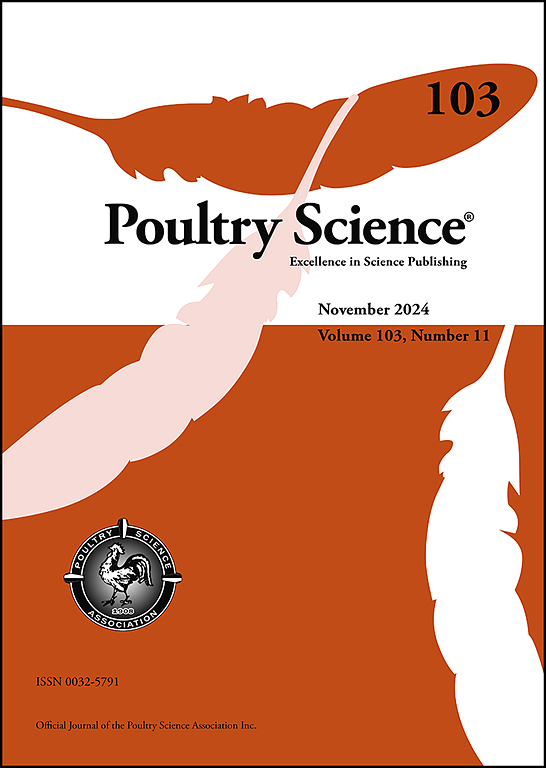减轻鹌鹑T-2毒素毒性:丁酸钠的保护作用
IF 3.8
1区 农林科学
Q1 AGRICULTURE, DAIRY & ANIMAL SCIENCE
引用次数: 0
摘要
T-2霉菌毒素是世界范围内农业生产中最常见的污染物之一,常见于发霉饲料及其原料中。它可以减缓农场动物的生长,抑制免疫功能,导致经济效益下降。丁酸钠作为饲料添加剂,具有增强机体免疫功能的作用。然而,T-2毒素对鹌鹑脾脏、胸腺和法氏囊的毒理学作用以及丁酸钠对T-2毒素的保护机制尚不清楚。采用T-2毒素(0.9 mg/kg)和丁酸钠(500 mg/kg)作为拮抗剂分别饲喂1日龄韩国鹌鹑,建立实验动物模型。连续给药28 d后观察T-2毒素亚慢性毒性鹌鹑免疫器官(脾脏、胸腺、法氏囊)的组织病理学变化。采用MASSON染色法和纤维化基因表达法观察T-2毒素和丁酸钠对免疫器官纤维化的影响,TUNEL法观察T-2毒素和丁酸钠对免疫器官凋亡的影响。测定凋亡相关基因的表达,评价T-2毒素对鹌鹑病理损伤、纤维化、凋亡和CYP450稳态的影响,同时测定丁酸钠对鹌鹑免疫器官的拮抗作用。结果表明,丁酸钠能有效减轻T-2毒素诱导的鹌鹑免疫器官病理损伤、纤维化、凋亡、异源核受体通路异常激活和CYP450稳态破坏。本文章由计算机程序翻译,如有差异,请以英文原文为准。
Mitigating T-2 toxin toxicity in Quail: The protective power of sodium butyrate
As one of the most common worldwide contaminants in agricultural production, the T-2 mycotoxin is commonly found in moldy feed and its raw materials. It can slow the growth and suppress the immune function of farm animals, resulting in reduced economic benefits. As a feed additive, sodium butyrate can enhance immune function. However, the toxicological effects of the T-2 toxin on the spleen, thymus, and bursa of Fabricius and the protective mechanism of sodium butyrate against the T-2 toxin in quails are not known. In this study, 1-day-old Korean quails were fed either with T-2 toxin (0.9 mg/kg) spiked food or with spiked food and sodium butyrate (500 mg/kg) as an antagonist, to construct an experimental animal model. Histopathological changes in the immune organs (spleen, thymus, and bursa of Fabricius) of the quails under sub-chronic toxicity of T-2 toxin were observed after 28 days of continuous treatment. The effects of the T-2 toxin and sodium butyrate on the fibrosis of the immune organs were investigated by MASSON staining and fibrosis gene expression, while the effects of the T-2 toxin and sodium butyrate on apoptosis of the immune organs were investigated by TUNEL assay. The expression of apoptosis-related genes was also measured to evaluate the effects of the T-2 toxin on pathological damage, fibrosis, apoptosis, and CYP450 homeostasis while the antagonistic effect of sodium butyrate on the quail immune organs was also measured. Results showed that sodium butyrate could effectively alleviate pathological damage, fibrosis, apoptosis, abnormal activation of the heterologous nuclear receptor pathway, and the disruption of CYP450 homeostasis induced by the T-2 toxin in quail immune organs.
求助全文
通过发布文献求助,成功后即可免费获取论文全文。
去求助
来源期刊

Poultry Science
农林科学-奶制品与动物科学
CiteScore
7.60
自引率
15.90%
发文量
0
审稿时长
94 days
期刊介绍:
First self-published in 1921, Poultry Science is an internationally renowned monthly journal, known as the authoritative source for a broad range of poultry information and high-caliber research. The journal plays a pivotal role in the dissemination of preeminent poultry-related knowledge across all disciplines. As of January 2020, Poultry Science will become an Open Access journal with no subscription charges, meaning authors who publish here can make their research immediately, permanently, and freely accessible worldwide while retaining copyright to their work. Papers submitted for publication after October 1, 2019 will be published as Open Access papers.
An international journal, Poultry Science publishes original papers, research notes, symposium papers, and reviews of basic science as applied to poultry. This authoritative source of poultry information is consistently ranked by ISI Impact Factor as one of the top 10 agriculture, dairy and animal science journals to deliver high-caliber research. Currently it is the highest-ranked (by Impact Factor and Eigenfactor) journal dedicated to publishing poultry research. Subject areas include breeding, genetics, education, production, management, environment, health, behavior, welfare, immunology, molecular biology, metabolism, nutrition, physiology, reproduction, processing, and products.
 求助内容:
求助内容: 应助结果提醒方式:
应助结果提醒方式:


